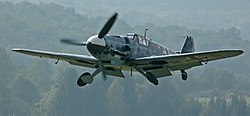
The Messerschmitt Bf 109 was a German World War II fighter aircraft designed by Willy Messerschmitt in the early 1930s. It was one of the first true modern fighters of the era, including such features as an all-metal monocoque construction, a closed canopy, and retractable landing gear. The Bf 109 was produced in greater quantities than any other fighter aircraft in history, with a total of 33,984 units produced up to April 1945. Fighter production totalled 47% of all German aircraft production, and the Bf 109 accounted for 57% of all German fighter types produced.
The Bf 109 was the backbone of the Luftwaffe fighter force in World War II, although it began to be partially replaced by the Focke-Wulf Fw 190 from 1941. The Bf 109 was the most successful fighter of World War II, shooting down more aircraft than any of its contemporaries. Originally conceived as an interceptor, it was later developed to fulfill multiple tasks, serving as bomber escort, fighter bomber, day-, night- all-weather fighter, bomber destroyer, ground-attack aircraft, and as reconnaissance aircraft.
The Bf 109 was flown by the three top-scoring fighter aces of World War II: Erich Hartmann, the top scoring fighter pilot of all time with 352 victories, Gerhard Barkhorn with 301 victories, and Günther Rall with 275 victories. All of them flew with Jagdgeschwader 52, a unit which exclusively flew the Bf 109 and was credited with over 10,000 victories, chiefly on the Eastern Front. Hartmann chose to fly the Bf 109 in combat throughout the war, despite being offered the use of the Me 262. Hans-Joachim Marseille, the highest scoring German ace in the North African Campaign, also scored all of his 158 victories flying the Bf 109, against Western Allied pilots.
- Span: 9.925 m (32 ft 6 in)
- Length: 8.95 m (29 ft 7 in)
- Height: 2.60 m (8 ft 2 in)
- Engine: 1× Daimler-Benz DB 605A-1 liquid-cooled inverted V12, 1,475 PS (1,455 hp, 1,085 kW)
- Cruising Speed: 590 km/h (365 mph) at 6,000 m (19,680 ft)
- First Flight: 28 May 1935